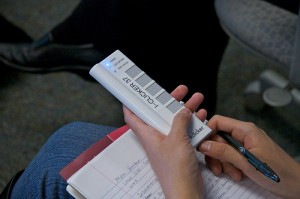How do you use clickers? Faculty share experiences from clicker pilot
 Teaching and Learning Technologies (TLT) held an end-of-term discussion luncheon titled “An Unfiltered Look at Clickers in the Classroom” on Wednesday, Dec. 5. Created to facilitate conversations among faculty about clicker usage on campus, TLT invited faculty members from all disciplines to share how clickers can be used as teaching tools.
Teaching and Learning Technologies (TLT) held an end-of-term discussion luncheon titled “An Unfiltered Look at Clickers in the Classroom” on Wednesday, Dec. 5. Created to facilitate conversations among faculty about clicker usage on campus, TLT invited faculty members from all disciplines to share how clickers can be used as teaching tools.
Twelve faculty members volunteered to test out clicker systems last fall as part of TLT’s clicker pilot program. Among those participants were Kyle Altmann, Lynn Beck, Wayne Bennett, Randall Bowman, Stephen Braye, Scott Buechler, Mark Courtright, Brooks Depro, Betty Garrison, Amy Hogan, Teresa LaPors, and Daryl Lawson. At the luncheon, these individuals shared stories concerning their clicker experiences and offered suggestions on how other faculty could incorporate clicker technology into their classrooms.
MORE: Read about TLT’s clicker pilot program here
Clickers: Gauges of Student Retention of Material
Most pilot participants said they used clickers to gauge student comprehension. The professor would pose a question, lecture or lead a class or group discussion, then re-ask the original question. The clickers allowed instructors to assess the amount of material students had digested during the class period, and they served as a reinforcement tool.
Stephen Braye, professor of English, found the immediacy of clickers helpful, as they calculated and released results within minutes. This instantaneous feedback allowed him to readjust his lectures to best meet the needs of his students.
“When two or three people out of 35 got [the answer] right, it made me stop and say, ‘OK, what am I doing wrong?’” Braye said.
Lynn Beck, a music instructor, utilized clickers similarly by incorporating them into warm-up exercises for assessment purposes.
“I found clickers most useful for drill work such as chord qualities,” Beck said. “They were very valuable for immediate feedback, and they allowed me to readjust to address student deficiencies. The students loved having something to hold and use, too.”
Faculty said they revisited old clicker reports to gauge long-term student progress and to evaluate their teaching methods as well.
“The reports provided me with a picture of context of what we were discussing,” Scott Buechler, assistant professor of business communications, said. “It was reassuring.”
Clickers: Stimulants of Class Discussion
All pilot participants said clickers encouraged class participation and collaboration among students.
Brooks Depro, adjunct assistant professor of economics, incorporated clickers in his courses primarily as a way to break up the hour and 40-minute time period. He was pleased to see how engaged students became with the technology.
“I used to ask a question to my classes and hear chirp, chirp, chirp, silence,” Depro said. “And these [clickers] really helped to get students engaged.”
Depro said he decided not to use clickers one day in his introductory-level economics courses, and his students seemed upset.
“They were almost disappointed to be honest with you because that’s what they were expecting,” Depro said. “They seem to like it.”
Amy Hogan, assistant professor of psychology, utilized clickers in a multitude of ways, from measuring class participation to calculating exam grades.
“Clickers helped to facilitate discussion, and they were a useful tool for taking attendance,” Hogan said. “I used them for exams, and students liked the immediate turnaround.”
Hogan said she required her students to answer 80 percent of the questions she posed during a given class period. She then calculated the percentage of answers students submitted and used those numbers to determine their participation grades.
Kyle Altmann, associate professor of physics, implemented clickers in his courses to measure student comprehension levels and to encourage group collaboration.
“I utilized conceptual-type questions that aimed at misconceptions students have about physics,” Altmann said. “It allowed students to have one-on-one interactions with each other that I can’t always provide in the classroom.”
Technological Issues
Though some pilot participants experienced technological difficulties, the majority said clickers were easy to use once they conquered the basics.
“As a newbie, I needed a good bit of prep when I first started using them,” Braye said. “There are some routine things, such as font size and log-in information, that I just need to remember.”
As class participation and discussion increased with the introduction of clickers in Hogan’s classes, she said she failed to budget enough time to finish her lectures.
“I didn’t get through as much content,” Hogan said. “Using clickers took more time than I anticipated. I need to allot more time next semester.”
Depro acknowledged there are many different ways instructors can employ clickers in their classrooms, but he said his simplistic approach to them may have eliminated the possibility of technical difficulties.
“I didn’t have any technological malfunctions all year,” Depro said. “They were not fancy, but they served their purpose.”
If you are interested in using clickers in your courses and would like some assistance, contact Teaching and Learning Technologies at 336.278.5006 or tlt@elon.edu.
Image by Flickr user alumroot / Creative Commons licensed BY-CC 2.0
 Follow
Follow


